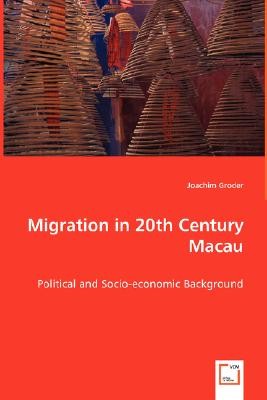
- We will send in 10–14 business days.
- Author: Joachim Groder
- Publisher: VDM Verlag Dr. Mueller E.K.
- Year: 2008
- Pages: 440
- ISBN-10: 3639002326
- ISBN-13: 9783639002324
- Format: 15.2 x 22.9 x 2.3 cm, minkšti viršeliai
- Language: English
- SAVE -10% with code: EXTRA
Reviews
Description
Macau, the small territory on the South China coast administered by the Portugal until 1999, saw major refugee waves, immigration, emigration and through-migration throughout the 20th century. The author looks at the 100-year period from the Boxer rebellion in 1900 up to the end of Portuguese administration and hand-over in 1999. These population movements and their accentuated oscillations were one of the main factors, if not the most important factor, shaping not only the demography of the territory but also its culture, society, politics and economy. How did the nature of these temporary or definitive migratory movements change over the years, in terms of size, composition, origin, push/pull factors and impact on the territory? The author draws on a wide range of primary sources from historical archives in Macau, Hong Kong, Lisbon and London. The publication is of interest not only to demographers, historians, and geographers, but also economists, social and political scientists and students of the East and South East Asian area.
EXTRA 10 % discount with code: EXTRA
The promotion ends in 22d.14:21:08
The discount code is valid when purchasing from 10 €. Discounts do not stack.
- Author: Joachim Groder
- Publisher: VDM Verlag Dr. Mueller E.K.
- Year: 2008
- Pages: 440
- ISBN-10: 3639002326
- ISBN-13: 9783639002324
- Format: 15.2 x 22.9 x 2.3 cm, minkšti viršeliai
- Language: English English
Macau, the small territory on the South China coast administered by the Portugal until 1999, saw major refugee waves, immigration, emigration and through-migration throughout the 20th century. The author looks at the 100-year period from the Boxer rebellion in 1900 up to the end of Portuguese administration and hand-over in 1999. These population movements and their accentuated oscillations were one of the main factors, if not the most important factor, shaping not only the demography of the territory but also its culture, society, politics and economy. How did the nature of these temporary or definitive migratory movements change over the years, in terms of size, composition, origin, push/pull factors and impact on the territory? The author draws on a wide range of primary sources from historical archives in Macau, Hong Kong, Lisbon and London. The publication is of interest not only to demographers, historians, and geographers, but also economists, social and political scientists and students of the East and South East Asian area.


Reviews